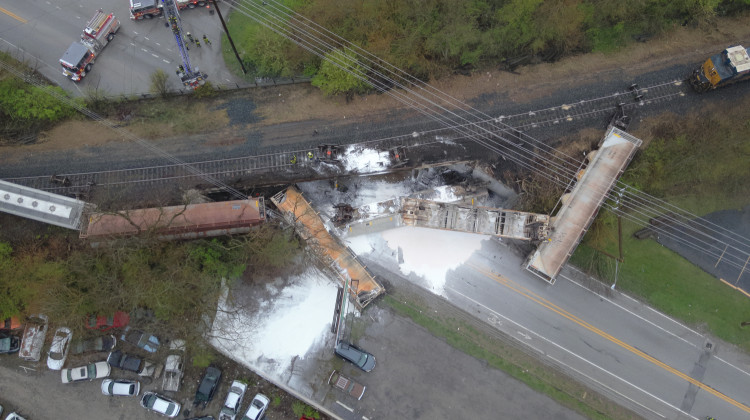
The Muncie Flyers, known as the Congerville Flyers for most of their existence, in a 1915 photograph by Otto Sellers. (Ball State University Digital Media Repository)
The National Football League is using this year’s Draft to celebrate its 14 original teams. One of those, surprisingly, hails from Muncie. IPR’s Stephanie Wiechmann talks with Delaware County Historical Society President Chris Flook about who the Muncie Flyers were and why they disappeared so quickly from the professional football lineup.
Stephanie Wiechmann: According to the NFL, the team that was known as the Muncie Flyers was also, at one point, known as the Congerville Flyers. So, what is Congerville and why the name change?
Chris Flook: Congerville was, at one point, a neighborhood in the south side of Muncie that was a working class, industrial neighborhood. Workers were managers that worked at Ball [Corporation] or any of the factories on the south side of town. Basically, south of Memorial, and north of 26th Street, and west of Madison.
In the first two decades of the 20th Century, there was just this Bush League football that existed all over Muncie. Churches and neighborhoods had their own teams. Congerville had two main teams – the Giants, who became the Flyers, and the Congerville Athletic Club when they merged, but they had a couple of B teams who were the seconds and the thirds. So, the impression, when you read through the newspapers in those first two decades is that football was very popular, very intramural, and very sort-of haphazard, but very popular.
And when the APFA (American Professional Football Association) was formed, they thought Congerville would be too obscure. So they became the Muncie Flyers to better reflect that they were the pre-eminent team of Muncie.
SW: Some of us of a certain age have seen the Goofy cartoon of early football and the rules of football. It looked pretty different – didn’t it – from the NFL games we see today?
CF: Yeah. I think that if we were transported back in time, we would not be lost. I think that we would understand the general game pay, but yeah, the rules were very much different. Their helmets were leather. They just wore sweaters. And it seems – and I’m not an expert here – it seems to be sort-of divided by weight. And so how it would work is, if you were a 140-pound team – so, the average weight was 140 pounds for the players – you would call out a rival team in the newspaper. You’d say, “We’re calling out the Congerville Flyers to play the Industry Linebusters on such-and-such time and day.” And they’d either show up or respond in the newspaper. So it just seems very informal and sort-of slapped together, as opposed to having what we have today, where everything is sort-of planned out.
SW: Once the team became part of the precursor to the NFL, the APFA, it didn’t last very long. Why was that?
CF: Muncie was just bad. I mean, they – in 1920, they were 0-1 in league play. And then in 1921, they were 0-2 in league play. They were just punching about their weight, really. And so they went back to playing the local teams, and they did quite well. They did quite well before joining the APFA and then after. And for all kinds of reasons, they just didn’t have enough money, there wasn’t enough resources, I think, to attract some of the folks that the other teams were able to get.
SW: If we had been better and if we had lasted, do you think we would be rooting for the Muncie Mighty Geese or something in the NFL?
CF: Maybe. My suspicion, though, who knows, but as a good counterfactual, my suspicion was if they grew to prominence, they would have moved to Indianapolis. If we had managed to keep a team, I think, at least in the 1940’s or ‘50’s, it would have moved to a larger city, or been bought out with someone who had more resources for better equipment that could pay for a player to have like a full-time job playing football.
At the end of it, of the first 14 teams, only two remained. Most of them folded within a couple of years. The Decatur Staleys became the Chicago Bears. And then the Chicago Cardinals went to St. Louis, and are now the Arizona Cardinals.
On Saturday, representatives from the Indianapolis Colts will be in Muncie to announce the team’s sixth round draft pick live from Canan Commons. That announcement is expected to take place sometime between 3:00 PM and 5:00 PM.
 DONATE
DONATE






 Support WFYI. We can't do it without you.
Support WFYI. We can't do it without you.